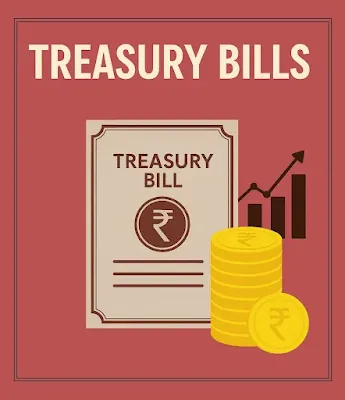Treasury Bills (T-Bills) are short-term debt instruments issued by the Central Government of India.
They are crucial components of the money market and are managed by the Reserve Bank of India (RBI).
Treasury Bills were introduced in India for the first time in 1917.
Why in News?
This action, executed through the State Bank of India (SBI), provides crucial financial support to the island nation grappling with economic challenges and debt.
This interest-free arrangement is part of a unique government-to-government understanding that began in 2019. It reflects India's 'Neighbourhood First' policy and its strategic interest in the Indian Ocean region.
The primary purpose of T-Bills is to enable the Central Government to meet its temporary mismatches in cash flow and short-term financial requirements, ie, meeting short-term funding needs of the government.
Historically, 14-day T-Bills were also issued, but the active ones are the three mentioned above.
Purpose of a Treasury Bill
This helps in managing the country's fiscal deficit.
The RBI uses T-Bills as a monetary tool for conducting Open Market Operations (OMOs) to manage liquidity in the economy.
Selling T-Bills absorbs excess liquidity, while buying them injects liquidity. This helps in regulating inflation and overall money supply.
For investors, T-Bills offer one of the safest and most liquid investment avenues in the Indian financial market, as they are backed by the sovereign guarantee of the Government of India.
Issuance
Only the Central Government can issue T-Bills in India. State Governments do not issue T-Bills, but they can issue State Development Loans (SDLs), which are generally long-term bonds.
The Reserve Bank of India (RBI) manages the issuance of T-Bills on behalf of the Central Government. They are also issued under the Market Stabilization Scheme (MSS).
Market Stabilization Scheme (MSS)
The Market Stabilization Scheme (MSS) is a monetary policy tool introduced by the RBI in 2004.
Its primary purpose is to absorb excess liquidity from the financial system, often arising from large capital inflows.
Under MSS, the government issues additional securities, including T-Bills and dated securities (bonds), which are then sold by the RBI.
The proceeds from these issues are kept in a separate account with the RBI and are not used for government expenditure.
This ensures that the absorption of liquidity is distinct from normal government borrowing.
Treasury Bills can be held in physical promissory note form, though this is now rare.
The prevalent method is the dematerialized form, either by crediting to an SGL (Subsidiary General Ledger) Account maintained with the RBI for institutions, or a Demat Account via depositories for retail investors.
This electronic holding enhances efficiency and safety.
Features of a Treasury Bill
The minimum investment amount for T-Bills is ₹25,000 and in multiples of Rs. 25,000.
Short-Term Maturity
T-Bills have maturity periods of less than one year. In India, they are currently issued in three standard tenures:
- 91-day T-Bills
- 182-day T-Bills
- 364-day T-Bills
Auctioning Process
T-Bills are issued through a weekly auction conducted by the RBI on its electronic platform, E-Kuber. The Public Debt Office (PDO) of the RBI acts as its registry/depository.
While 91-day T-bills are typically auctioned every week, both 182-day T-bills and 364-day T-bills are auctioned every alternate week by the Reserve Bank of India (RBI).
In India, the auction methods for Treasury Bills differ based on their maturity:
- 91-day T-bills typically follow a uniform price auction method. In this method, all successful bidders are allotted the T-bills at a single, uniform price (the cut-off price/yield discovered in the auction).
- 364-day T-bills (and often 182-day T-bills) follow a multiple price auction method. In this method, successful bidders are allotted the T-bills at the exact price/yield they bid, provided it is at or below the cut-off price/yield.
Both competitive and non-competitive bidding are allowed.
Non-competitive bidding allows smaller investors, including individuals, to participate without having to quote a yield or price.
Zero-Coupon Securities
T-Bills do not pay any periodic interest (coupon). Instead, they are issued at a discount to their face value and are redeemed at their full face value upon maturity.
The return to the investor is the difference between the discounted issue price and the face value.
Eg:- A T-Bill with a face value of ₹100 might be issued at ₹98. On maturity, the investor receives ₹100, making a profit of ₹2.
High Liquidity
Due to their short maturity and government backing, T-Bills are highly liquid and can be easily traded in the secondary market.
Risk-Free (Gilt-Edged)
T-Bills are considered practically risk-free as they carry the sovereign guarantee, implying almost no risk of default. This is why they are often referred to as 'gilt-edged' securities.
SLR Requirement
Commercial banks often hold T-Bills to meet their Statutory Liquidity Ratio (SLR) requirements set by the RBI. They can also be used as collateral for repo transactions with the RBI.
Taxation
The return earned on T-Bills (the difference between the issue price and face value) is treated as short-term capital gain and is taxable as per the investor's applicable income tax slab.
Conclusion
Treasury Bills are vital short-term borrowing instruments for the government, a key monetary policy tool for the RBI, and a safe, liquid investment avenue for both institutional and retail investors.
They form an essential part of the Indian financial ecosystem, contributing to fiscal management, liquidity control, and market stability.
Thanks for reading!!!









Post a Comment
Post a Comment